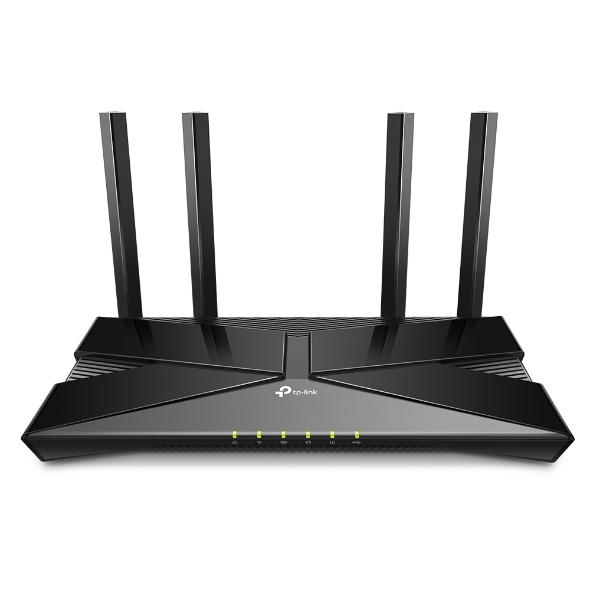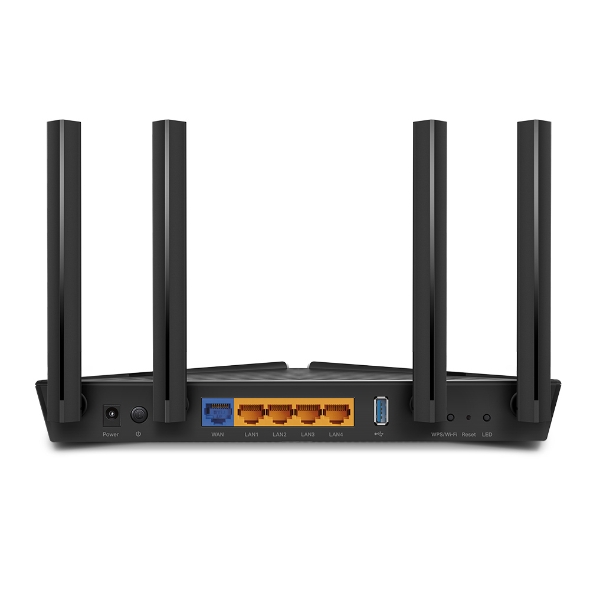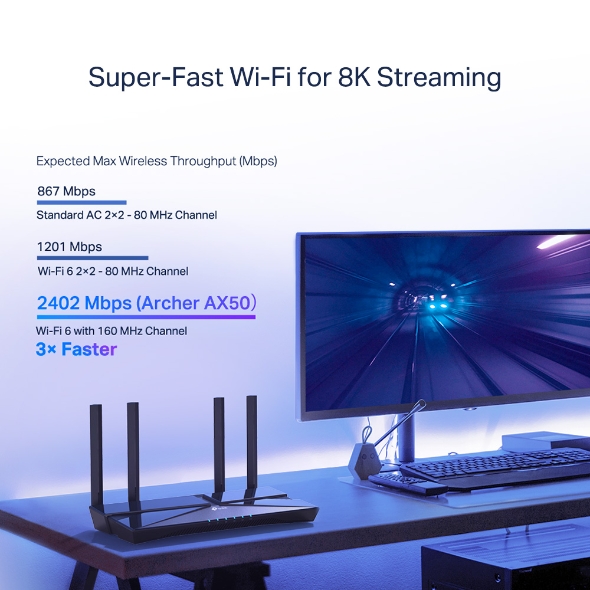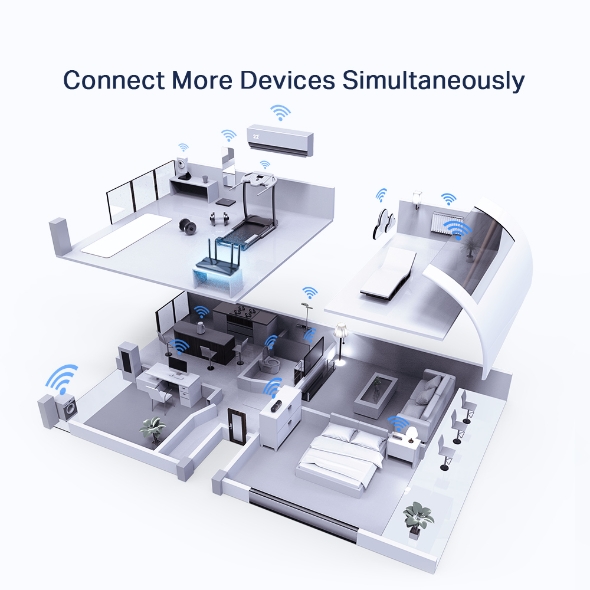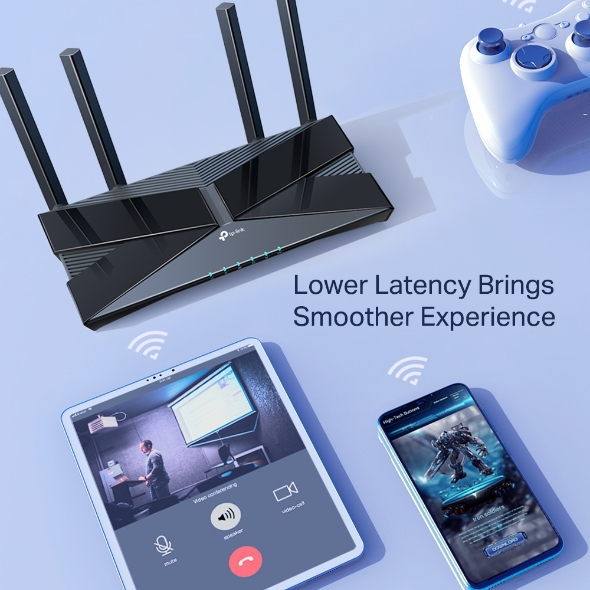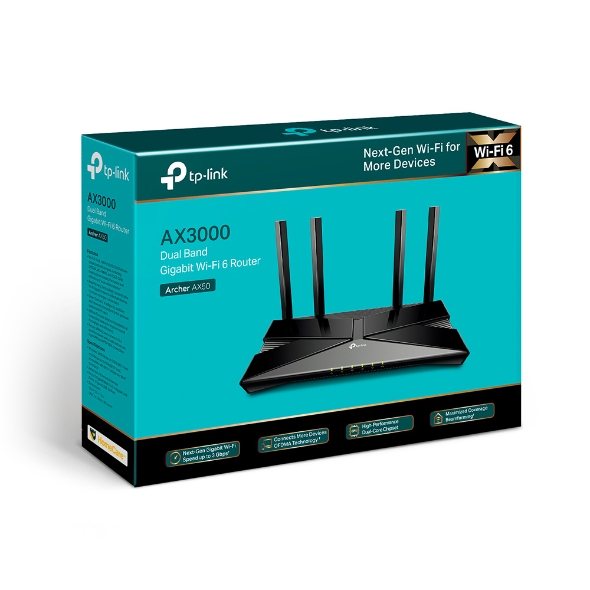Archer AX50
End of LifeAX3000 Dual Band Gigabit Wi-Fi 6 Router
- Next-Gen Gigabit Wi-Fi 6 Speed—2402 Mbps on 5 GHz and 574 Mbps on 2.4 GHz band ensure smoother streaming and faster downloads.
- Connect More Devices—OFDMA and MU-MIMO technology increase capacity by 4 times to enable simultaneous transmission to more devices.
- Ultra-Low Latency—Up to 75% reduction in latency enables more responsive gaming and video chatting.
- Expanded Wi-Fi Coverage—Four high-gain external antennas and Beamforming technology combine to extend strong, reliable Wi-Fi throughout your home.
- Enhanced Security—More secure and trusted Wi-Fi with TP-Link HomeCare™.
- Reliable Connections—Intel® Home Wi-Fi Chipset greatly increases processing speed to deliver superior Wi-Fi 6 Gig+ performance.
- Improved Battery Life—Target Wake Time helps your devices to communicate more while consuming less power.
- Compatible with Alexa—Control your router via voice commands and make your life smarter and easier with Amazon Alexa.
The Next Wave of
Home Connectivity
AX3000 Gigabit Wi-Fi 6 Router
Archer AX50
The Next Generation of Wi-Fi is Upon Us
Wi-Fi 6 (802.11ax) could turn out to be the most significant advancement in Wi-Fi development, delivering a huge boost in speed and total capacity. Mainstream adoption of Wi-Fi 6 is inching ever closer with more and more AX clients available. It's the right time to upgrade your router to the newest generation of Wi-Fi!
Learn more about Wi-Fi 6 (802.11ax)
WI-FI 6
- 3× Faster Speed
- 4× Capacity
- 75% Lower Latency
- Improved Security
Blazingly Fast Gig+ Speed Can't Wait
There is no reason to hold off on buying a Wi-Fi 6 router when you can already take full advantage of the speed it delivers. Featuring a 160 MHz bandwidth and 1024-QAM, Archer AX50 delivers true gigabit speeds of up to 3 Gbps. Enjoy faster streaming and gaming like never before. Powered by Intel® Home Wi-Fi WAV654 chipset for a full-featured Wi-Fi 6 AX3000 router, to pair perfectly with new Intel® Wi-Fi 6 Gig+ PCs and laptops, allowing numerous bandwidth-intensive tasks to run smoothly at the same time.‡
Expected Max Wireless Throughput (Mbps)
-
867 Mbps
Standard AC 2×2 - 80 MHz Channel
-
1201 Mbps
Wi-Fi 6 2×2 - 80 MHz Channel
-
2402 Mbps (Archer AX50)
Intel Wi-Fi 6 Gig+ Speed -160 MHz Channel§
3× Faster
Reliable Connections for up to 256 Devices
In answer to ever growing demands on home Wi-Fi, Archer AX50 future-proofs your home networks by providing 4× greater capacity to connect more devices. Advanced technologies, such as OFDMA and MU-MIMO, quadruple the connection capacity in high-density scenarios compared to standard 802.11ac routers. Keep pace with the latest technology and future developments.**
Lower Latency,
Greater Experience.
Taking a giant leap forward in wireless connectivity, Wi-Fi 6 brings stable and responsive Wi-Fi connections to tomorrow's hyperconnected homes. Enjoy more responsive gaming and seamless video conferencing even when multiple compatible device are connected and transmitting data at the same time.
UP TO 75%
reduction in latency*
HomeCare™
More Secure,
and More Trusted Wi-Fi
Create a customized Wi-Fi network with enhanced security using TP-Link HomeCare™. Whether protecting your sensitive data or limiting the access of kids and guests, HomeCare™ gives you the tools you need to fully manage your network.
-
Robust
Parental ControlsBlock inappropriate content and restrict time spent online
-
Built-In Antivirus
Protect all connected devices in your home from online threats
-
Quality of Service
Prioritize devices and applications for faster performance when needed
Expanded Coverage Throughout Your Home
Four high-gain external antennas and Beamforming technology combine to extend strong, reliable Wi-Fi throughout your home. Cutting-edge Wi-Fi 6 technologies, such as BSS Color, ensure smooth and stable connections by eliminating signal interference from your neighbors.‡
Reduce Devices’
Power Consumption
While Wi-Fi 6 clients are starting to hit the market in meaningful numbers, the newest AX technology—Target Wake Time—helps your devices to communicate more while consuming less power. Mobile and IoT devices that support TWT negotiate when and how often they will wake up to send or receive data, increasing sleep time and substantially prolonging battery life.****
Easy Management with Tether
Set up your router in minutes via its intuitive web interface or the powerful Tether app. Tether also lets you manage its network settings, including parental controls and media sharing, from any Android or iOS device.
Ready for Today and Tomorrow's Smart Home
With the growing number of devices in today's home, everyone deserves a smarter and easier way to bring all your products together. Utilize Amazon Alexa to control everything via voice commands to enjoy truly intelligent life.
Learn about Alexa integration >>
Learn about our custom Alexa skills >>

“Alexa, tell TP-Link to prioritize my phone’s Wi-Fi connection”
| WIRELESS | |
|---|---|
| Standards | Wi-Fi 6IEEE 802.11ax/ac/n/a 5 GHzIEEE 802.11ax/n/b/g 2.4 GHz |
| WiFi Speeds | AX30005 GHz: 2402 Mbps (802.11ax, HE160)2.4 GHz: 574 Mbps (802.11ax) |
| WiFi Range | 3 Bedroom Houses 4× Fixed High-Performance AntennasMultiple antennas form a signal-boosting array to cover more directions and large areasBeamformingConcentrates wireless signal strength towards clients to expand WiFi rangeHigh-Power FEMImproves transmission power to strengthen signal coverage |
| WiFi Capacity | High Dual-BandAllocate devices to different bands for optimal performanceOFDMASimultaneously communicates with multiple Wi-Fi 6 clientsAirtime FairnessImproves network efficiency by limiting excessive occupationDFSAccess an extra band to reduce congestion4 StreamsConnect your devices to more bandwidth |
| Working Modes | Router ModeAccess Point Mode |
| SECURITY | |
|---|---|
| Network Security | SPI FirewallAccess ControlIP & MAC BindingApplication Layer GatewayHomeCare™ Antivirus Malicious Site CheckerPort Intrusion PreventionInfected Device IsolationNotification and Log |
| Guest Network | 1× 5 GHz Guest Network1× 2.4 GHz Guest Network |
| VPN Server | OpenVPNPPTP |
| WiFi Encryption | WEPWPAWPA2WPA/WPA2-Enterprise (802.1x) |
| HARDWARE | |
|---|---|
| Processor | Dual-Core CPU |
| Ethernet Ports | 1× Gigabit WAN Port4× Gigabit LAN PortsStatic Link Aggregation (LAG) available with 2× LAN ports |
| USB Support | 1× USB 3.0 PortSupported Partition Formats:NTFS, exFAT, HFS+, FAT32Supported Functions:Apple Time MachineFTP ServerMedia ServerSamba Server |
| Buttons | Wi-Fi/WPS ButtonPower On/Off ButtonLED On/Off ButtonReset Button |
| Power | 12 V ⎓ 2 A |
| SOFTWARE | |
|---|---|
| Protocols | IPv4IPv6 |
| Service Kits | HomeCare™Learn More> |
| Parental Controls | HomeCare™ Parental Controls Custom ProfilesContent FilteringApp BlockURL FilteringTime Limit Time Schedule (Bedtime)Log Insight |
| WAN Types | Dynamic IPStatic IPPPPoEPPTPL2TP |
| Quality of Service | QoS by DeviceHomeCare™ QoS QoS by Application |
| Cloud Service | Auto Firmware UpgradeOTA Firmware UpgradeTP-Link IDDDNS |
| NAT Forwarding | Virtual ServersPort ForwardingPort TriggeringDMZUPnP |
| IPTV | IGMP ProxyIGMP SnoopingBridgeTag VLAN |
| DHCP | Address ReservationDHCP Client ListServer |
| DDNS | TP-LinkNO-IPDynDNS |
| Management | Tether AppWebpageCheck Web Emulator> |
| OTHER | |
|---|---|
| System Requirements | Internet Explorer 11+, Firefox 12.0+, Chrome 20.0+, Safari 4.0+, or other JavaScript-enabled browserCable or DSL Modem (if needed)Subscription with an internet service provider (for internet access) |
| Certifications | FCC, CE, RoHS |
| Environment | Operating Temperature: 0℃~40℃ (32℉ ~104℉)Storage Temperature: -40℃~70℃ (-40℉ ~158℉)Operating Humidity: 10%~90% non-condensingStorage Humidity: 5%~90% non-condensing |
| TEST DATA | |
|---|---|
| WiFi Transmission Power | CE: <20dBm(2.4GHz)<23dBm(5.15GHz~5.35GHz)<30dBm(5.47GHz~5.725GHz)FCC:<30dBm(2.4GHz & 5.15GHz~5.825GHz) |
| WiFi Reception Sensitivity | 5 GHz:11a 6Mbps:-97dBm, 11a 54Mbps:-79dBm11ac VHT20_MCS0:-96dBm, 11ac VHT20_MCS11:-66dBm11ac VHT40_MCS0:-94dBm, 11ac VHT40_MCS11:-63dBm11ac VHT80_MCS0:-91dBm, 11ac VHT80_MCS11:-60dBm11ac VHT160_MCS0:-88dBm, 11ac VHT160_MCS11:-55dBm11ax HE20_MCS0:-95dBm, 11ax HE20_MCS11:-63dBm11ax HE40_MCS0:-92dBm,11ax HE40_MCS11:-60dBm11ax HE80_MCS0:-89dBm, 11ax HE80_MCS11:-58dBm11ax HE160_MCS0:-85dBm, 11ax HE160_MCS11:-55dBm2.4 GHz:11g 6Mbps:-97dBm, 11a 54Mbps:-79dBm11n HT20_MCS0:-97dBm,11n HT20_MCS7:-78dBm11n HT40_MCS0:-95dBm, 11n HT40_MCS7:-75dBm11ac VHT20_MCS0:-96dBm,11ac VHT20_MCS11:-67dBm11ac VHT40_MCS0:-94dBm, 11ac VHT40_MCS11:-64dBm11ax HE20_MCS0:-96dBm, 11ax HE20_MCS11:-64dBm11ax HE40_MCS0:-93dBm, 11ax HE40_MCS11:-61dBm |
| PHYSICAL | |
|---|---|
| Dimensions (W×D×H) | 10.2 × 5.3 × 1.5 in(260.2 x 135.0 x 38.6 mm) |
| Package Contents | Wi-Fi Router Archer AX50Power AdapterRJ45 Ethernet CableQuick Installation Guide |
- Reviews
-
-
After testing and evaluating 30 routers over 250 hours, we’ve determined that the best router for wirelessly connecting your laptops, your smart devices, and anything else your daily life depends on is the TP-Link Archer AX50.
-
†Maximum wireless signal rates are the physical rates derived from IEEE Standard 802.11 specifications. Range, coverage, and the maximum number of connected devices are based on test results under normal usage conditions. Actual wireless data throughput, wireless coverage, and number of connected devices are not guaranteed and will vary as a result of 1) environmental factors, including building materials, physical objects, and obstacles, 2) network conditions, including local interference, volume, and density of traffic, product location, network complexity, and network overhead, and 3) client limitations, including rated performance, location, connection quality, and client condition.
‡Use of Wi-Fi 6 (802.11ax), and features including OFDMA, MU-MIMO, and 1024-QAM require clients to also support the corresponding features.
§HE160 requires client device that supports 160 MHz bandwidth on Wi-Fi.
△802.11ax 2x2 160 MHz enables 2402 Mbps maximum theoretical data rates, 3X faster than standard 802.11ac 2x2 80 MHz (867 Mbps) and nearly 6x faster than baseline 1x1ac (433 Mbps) Wi-Fi as documented in IEEE 802.11 wireless standard specifications, and require the use of similarly configured 802.11ax wireless network routers.
*“Up to 75% lower latency” is based on Intel simulation data of 802.11ax with and without OFDMA using 9 clients. Average latency without OFDM is 36ms, with OFDMA average latency is reduced to 7.6ms. Latency improvement requires that the AP and all clients support OFDMA.
**This amendment defines standardized modifications to both the IEEE 802.11 physical layers (PHY) and the IEEE 802.11 Medium Access Control layer (MAC) that enable at least one mode of operation capable of supporting at least four times improvement in the average throughput per station (measured at the MAC data service access point) in a dense deployment scenario, while maintaining or improving the power efficiency per station.
***Intel and the Intel logo are trademarks of Intel Corporation or its subsidiaries in the U.S. and/or other countries.
****Saving clients' battery power requires clients to also support the 802.11ax Wi-Fi standard. Actual power reduction may vary as a result of network conditions, client limitations, and environmental factors.
